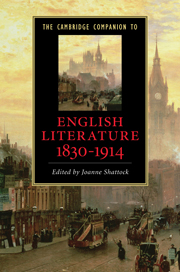12 - Visual culture
from Part II - Intersections and incursions
Published online by Cambridge University Press: 28 November 2010
Summary
'Seeing,' says the proverb, 'is believing,' but seeing also is feeling. And this is George Eliot’s great gift that she sees and makes her readers see the personages of her tale.
[E. S. Dallas], The Times (1866)E. S. Dallas’s review of George Eliot’s Felix Holt the Radical (1866) exemplifies the way nineteenth-century literature, and realism in particular, often defined its practice through visual tropes. The period had an almost compulsive fascination with visuality because it was the crucible for working through broader tensions between the material and the ideal, imagination and reality, the seen and the unseen. Dallas’s praise is typically double-edged in that seeing is simultaneously knowing and feeling, an epistemology and a phenomenology. His praise equates the truth-value of Eliot’s work with the vividness of her pictorial style, defined as the capability of imagining a scene as if it was a painting. Nonetheless, for all Eliot’s corresponding realism, Dallas’s invocation of the proverb actually emphasizes that seeing is a perceptual, subjective process. The concrete 'seeing' of Eliot and her readers is lauded precisely because it is an ideal and imaginative, yet embodied, act. Seeing might be believing, but the Victorians' fascination with processes of perception and illusion, often explored through optical devices, meant they were all too aware of how such belief could be misplaced.
The multivalent discourses of nineteenth-century visuality are evident in the conflicting function of the large number of pictorial and optical tropes in literary texts. Taken as a whole, their prevalence reflects the intimate relationship between literature and the burgeoning variety of visual media. Many studies have demonstrated their creative interaction, whether through tracing the influence of different visual arts and technologies upon individual writers or through more general explorations, such as the impact of photography and painting upon conceptions of realism. One notable study by Martin Meisel has gone so far as to argue that a common aesthetic style, combining narrative with pictorialism, runs through much nineteenth-century literature, painting and drama.
- Type
- Chapter
- Information
- The Cambridge Companion to English Literature, 1830–1914 , pp. 222 - 248Publisher: Cambridge University PressPrint publication year: 2010
- 1
- Cited by

